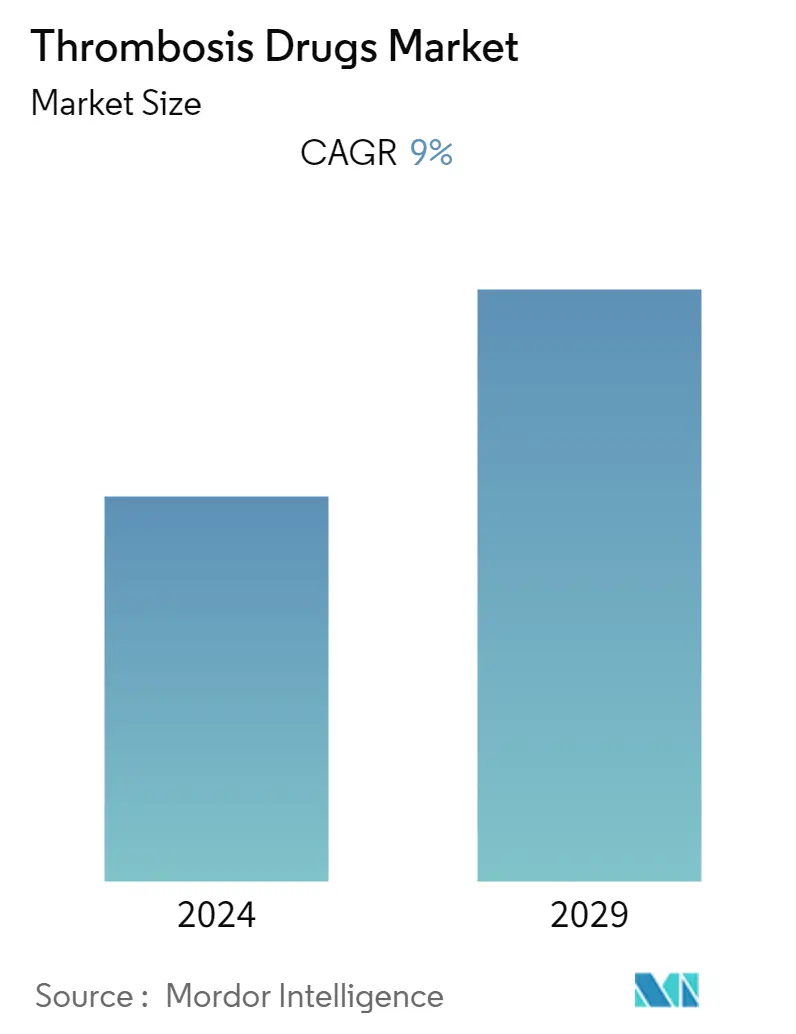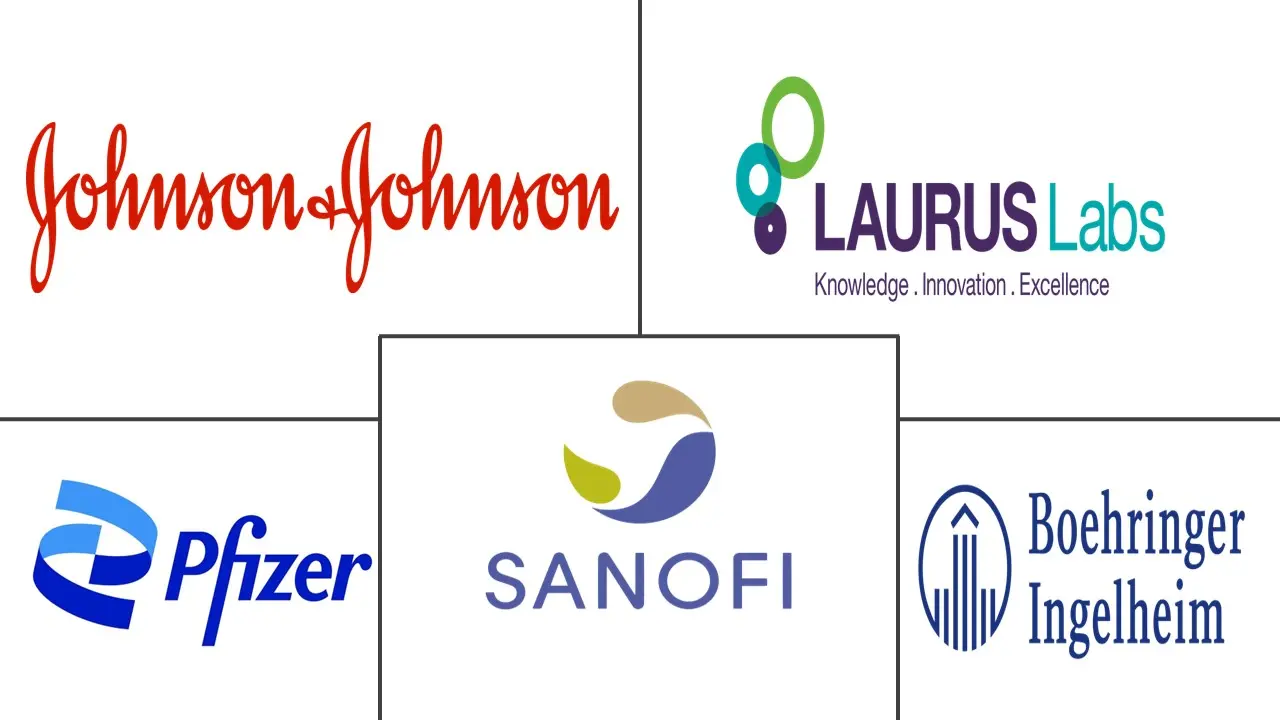Market Size of Thrombosis Drugs Industry

| Study Period | 2019 - 2029 |
| Base Year For Estimation | 2023 |
| CAGR | 9.00 % |
| Fastest Growing Market | Asia-Pacific |
| Largest Market | North America |
| Market Concentration | Medium |
Major Players
*Disclaimer: Major Players sorted in no particular order |
Thrombosis Drugs Market Analysis
The thrombosis drugs market is expected to register a CAGR of about 9.0% over the forecast period.
The COVID-19 pandemic had a significant impact on the studied market growth. For instance, according to the World Health Organization, 2021, services for cardiovascular crises have been interrupted partially or entirely in more than half of the nations examined during the early pandemic. Furthermore, according to the study published in the British Medical Journal in December 2021, in individuals with COVID-19, antiplatelet therapy (APT) may help reduce mortality; a randomized experiment (RECOVERY) found that aspirin therapy is linked to a 1.2% absolute gain in survival. Thus, the COVID-19 outbreak affected the market's growth significantly; however, as the pandemic has currently subsided, the market is expected to experience pre-pandemic growth levels during the study's forecast period.
The market is primarily driven by the increase in the geriatric and obese population, the rising burden of cardiovascular diseases and trauma cases, and the technological advancement in haematology. For instance, according to the United Nations World Population Prospects 2022, the share of the global population aged 65 years or above is projected to rise from 10 per cent in the current year to 16 per cent in 27 years. The source also stated that by 2050, the number of persons aged 65 years or over worldwide is projected to be more than twice the number of children under age five and about the same as that of children under age 12. Since the older population is prone to the disease, it is expected to generate the need for these drugs for treatment, thereby driving the market's growth.
Additionally, the increasing burden of obesity has also changed significantly in the last decade globally. Developed and emerging markets are having significant issues controlling the associated diseases. The growing consumption of alcohol and tobacco, with overweight and obesity, adds a high risk of developing significant blood pressure in veins for a long period of life, leading to several thrombosis-related complications, thus driving this market. For instance, according to the World Health Organization Report of March 2022, globally, over 1 billion individuals, including 650 million adults, 340 million teenagers, and 39 million children, were obese in 2022. Additionally, 167 million adults and children are expected to have worse health in two years due to being overweight or obese. Thus, with the increase in the obese population, the demand for thrombotic drugs is expected to increase over the forecast period as obesity is a significant cause of vascular diseases. Other factors contributing to the growth of this market are increasing the burden of cardiovascular and trauma cases, and the increasing research and development expenditure in the field of hematological disorders.
However, a lack of awareness about venous thromboembolism conditions and the side effect associated with thrombosis drugs may restrain the market growth over the forecast period.
Thrombosis Drugs Industry Segmentation
As per the scope of the report, a thrombus is a blood clot that develops on the inside of the heart or on the walls of blood vessels as a result of the adhesion of blood platelets, proteins, and cells. Thrombosis is considered to be the major source of morbidity and mortality among elderly patients. It has been established that thrombosis is caused due to certain cardiovascular disorders as a result of old age or obesity. The thrombosis drugs market is segmented by drug class (Factor Xa Inhibitor, Heparin, P2Y12 Platelet Inhibitor, and other drug classes), disease type (pulmonary embolism, atrial fibrillation, deep vein thrombosis, and other disease types), distribution channel (hospital pharmacies, retail pharmacies, online pharmacies), and geography (North America, Europe, Asia-Pacific, Middle East and Africa, and South America). The market report also covers the estimated market sizes and trends for 17 different countries across major regions, globally. The report offers the value (in USD) for the above segments.
| By Drug Class | |
| Factor Xa Inhibitor | |
| Heparin | |
| P2Y12 Platelet Inhibitor | |
| Other Drug Classes |
| By Disease Type | |
| Pulmonary Embolism | |
| Atrial Fibrillation | |
| Deep Vein Thrombosis | |
| Other Disease Types |
| By Distribution Channel | |
| Hospital Pharmacies | |
| Retail Pharmacies | |
| Online Pharmacies |
| Geography | ||||||||
| ||||||||
| ||||||||
| ||||||||
| ||||||||
|
Thrombosis Drugs Market Size Summary
The thrombosis drugs market is poised for significant growth, driven by an increasing geriatric and obese population, a rising burden of cardiovascular diseases, and advancements in hematology technology. The market's expansion is further supported by the growing prevalence of conditions such as deep vein thrombosis (DVT) and the introduction of innovative treatments. The COVID-19 pandemic initially disrupted market growth, but as it subsides, the market is expected to return to pre-pandemic growth levels. The demand for thrombosis drugs is anticipated to rise as the older population, more susceptible to vascular diseases, continues to grow. Additionally, the global increase in obesity, linked to lifestyle factors like alcohol and tobacco consumption, is expected to contribute to the market's expansion, as obesity is a significant risk factor for thrombosis-related complications.
North America is projected to hold a substantial share of the thrombosis drugs market, driven by the high prevalence of cardiovascular diseases and obesity, along with a growing elderly population. The region's early adoption of new technologies and the presence of a diverse patient pool further bolster market growth. Key players in the market, such as Bayer AG, Boehringer Ingelheim GmbH, and Pfizer Inc., are actively engaging in strategies like product launches and acquisitions to strengthen their market positions. Despite challenges such as a lack of awareness about venous thromboembolism and potential side effects of thrombosis drugs, the market is expected to witness robust growth, supported by increasing research and development investments in hematological disorders and the ongoing demand for advanced therapeutic options.
Thrombosis Drugs Market Size - Table of Contents
-
1. MARKET DYNAMICS
-
1.1 Market Overview
-
1.2 Market Drivers
-
1.2.1 Growing Geriatric and Obese Population
-
1.2.2 Increasing Burden of Cardiovascular and Trauma Cases
-
1.2.3 Increasing Technological Advancements in Hematology
-
-
1.3 Market Restraints
-
1.3.1 Lack of Awareness about Venous Thromboembolism Conditions
-
1.3.2 Side Effects Caused, due to Thrombosis Drugs
-
-
1.4 Porter's Five Forces Analysis
-
1.4.1 Bargaining Power of Suppliers
-
1.4.2 Bargaining Power of Buyers/Consumers
-
1.4.3 Threat of New Entrants
-
1.4.4 Threat of Substitute Products
-
1.4.5 Intensity of Competitive Rivalry
-
-
-
2. MARKET SEGMENTATION (Market Size by Value - USD)
-
2.1 By Drug Class
-
2.1.1 Factor Xa Inhibitor
-
2.1.2 Heparin
-
2.1.3 P2Y12 Platelet Inhibitor
-
2.1.4 Other Drug Classes
-
-
2.2 By Disease Type
-
2.2.1 Pulmonary Embolism
-
2.2.2 Atrial Fibrillation
-
2.2.3 Deep Vein Thrombosis
-
2.2.4 Other Disease Types
-
-
2.3 By Distribution Channel
-
2.3.1 Hospital Pharmacies
-
2.3.2 Retail Pharmacies
-
2.3.3 Online Pharmacies
-
-
2.4 Geography
-
2.4.1 North America
-
2.4.1.1 United States
-
2.4.1.2 Canada
-
2.4.1.3 Mexico
-
-
2.4.2 Europe
-
2.4.2.1 Germany
-
2.4.2.2 United Kingdom
-
2.4.2.3 France
-
2.4.2.4 Italy
-
2.4.2.5 Spain
-
2.4.2.6 Rest of Europe
-
-
2.4.3 Asia-Pacific
-
2.4.3.1 China
-
2.4.3.2 Japan
-
2.4.3.3 India
-
2.4.3.4 Australia
-
2.4.3.5 South Korea
-
2.4.3.6 Rest of Asia-Pacific
-
-
2.4.4 Middle East and Africa
-
2.4.4.1 GCC
-
2.4.4.2 South Africa
-
2.4.4.3 Rest of Middle East and Africa
-
-
2.4.5 South America
-
2.4.5.1 Brazil
-
2.4.5.2 Argentina
-
2.4.5.3 Rest of South America
-
-
-
Thrombosis Drugs Market Size FAQs
What is the current Global Thrombosis Drugs Market size?
The Global Thrombosis Drugs Market is projected to register a CAGR of 9% during the forecast period (2024-2029)
Who are the key players in Global Thrombosis Drugs Market?
Boehringer Ingelheim GmbH, Johnson & Johnson, Sanofi SA, Pfizer Inc. and Laurus Lab (Aspen Pharmacare Holdings Limited) are the major companies operating in the Global Thrombosis Drugs Market.

